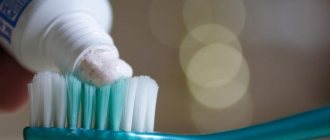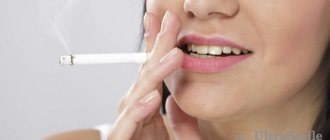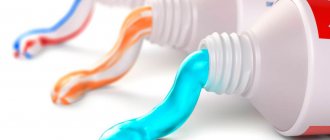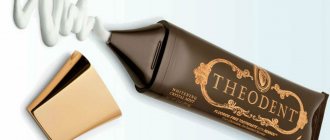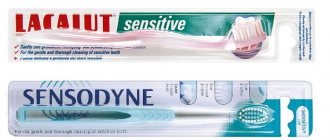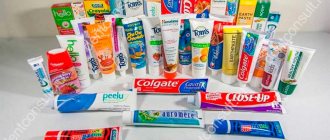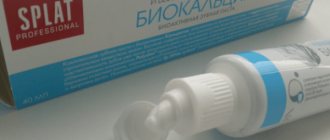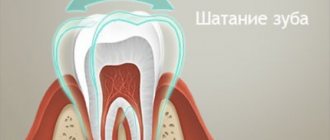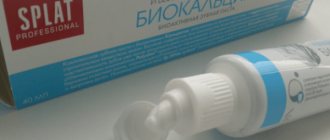People have begun to pay more and more attention to the composition of the products they use in everyday life, and this is no coincidence. It is worth looking at any label, and familiar elements of the periodic table and various chemical compounds appear before the eyes of the consumer, which, on the one hand, can be beneficial, and on the other, harmful.
After all, many components of chemical origin, when they enter the body, accumulate and can subsequently cause serious diseases, which cannot be said about natural ingredients. This is especially true for toothpastes that come into daily contact with our mucous membranes, which have excellent absorption ability.
- Why are regular toothpastes dangerous?
- Fluorides: pros and cons
- Compound
- harmful
- safe
- Benefits of natural remedies
- List of the best
- Thai
- ayurvedic powders
- for children
- Choice
- Making your own tooth powder at home
- Why you need natural toothpaste
Mint
Peppermint or lemon balm extract is the most common natural ingredient found in toothpastes. Mint has antibacterial, antioxidant, antiallergenic, analgesic, anesthetic and anti-inflammatory effects. The leaves of this plant are a storehouse of natural benefits, and the taste of mint, unlike eucalyptus or menthol, is considered pleasant by almost every person. In toothpastes, mint extract is responsible for its pleasant taste, as well as its refreshing and antibacterial effect. You will find the mint component in “Vanilla and Mint” pastes from JASON,.
Therapeutic and prophylactic toothpastes for every day with natural ingredients
Toothpaste is designed to cleanse the oral cavity of food debris, suppress the growth of pathogenic microorganisms, thereby preventing the destruction of tooth enamel, inflammation of the mucous membranes and gums of the oral cavity, and contain components of “nutrition” and strengthening of the components of the oral cavity.
Toothpaste for preserving gums (prevention of periodontitis and periodontal disease) and maintaining pH balance in the oral cavity.
There are no age restrictions for use. (https://nspclub.org/?a=291 ( SECTION: NSP products SUB-SECTION: Toothpastes)
Toothpaste for natural protection of tooth enamel from cariogenic bacteria and maintaining pH balance in the oral cavity. (https://nspclub.org /?a=206 ( SECTION: NSP Products SUB SECTION: Toothpastes)
Since toothpaste is the main means of hygiene of the oral mucosa, it must meet a number of specific requirements:
- be safe for the mucous membranes and the body;
- It is good to remove plaque without damaging the gums and tooth enamel;
- prevent plaque from occurring;
- influence the mineralization of teeth;
- strengthen the protective functions of the oral mucosa;
- have antimicrobial and periodontal protective properties;
- have a deodorizing and refreshing effect.
Throughout his entire adult life, a person on average “absorbs” from two to five kilograms of toothpaste! Scientists have found that young children reflexively swallow about 40% of toothpaste when brushing their teeth. It is important to understand that from the oral cavity, thanks to the mucous membrane, iodine, copper, iron, potassium, fluorine, sodium, zinc, vitamins, amino acids, etc., if they are components of toothpaste, enter the bloodstream in a matter of seconds. Thus, beneficial substances penetrate into the oral mucosa, then into the blood capillaries, then into the pulp of the tooth, and from the pulp into the enamel. But along with useful substances, we also “eat” antibiotics (triclosan, chlorhexedine, hexedine, metranidazole), flavorings, sweeteners (potassium acesulfate, sodium cyclomate, aspartame), sodium lauryl and laureth sulfate.
It is the composition of the toothpaste that determines how long we can use this or that toothpaste without harm to the body. The ingredients of chemical synthesis of toothpaste efficiently remove plaque accumulating on enamel, effectively suppress pathogenic microflora, and have good whitening properties. Active chemical components act quickly, which is an important advantage, but at the same time they are not able to fully “nourish” the gums and adjacent tissues, restore them, soothe and protect them. Moreover, with prolonged use of an artificial composition, the microflora becomes accustomed to synthetic substances, as a result of which the anti-inflammatory properties and, accordingly, the effect of use are reduced. The period of use of such toothpastes is determined by the doctor, but in general it is no more than 3-4 weeks. The instructions for use indicate that after brushing your teeth, you must rinse your mouth thoroughly. This is not surprising - getting remnants of toothpaste into the body is not only undesirable, but even dangerous. Such pastes are contraindicated for children.
Toothpastes of combined compositions (containing both synthetic and natural ingredients) are more acceptable for use. Substances of natural origin compensate for the aggressive effect of artificial components and have a beneficial effect on the mucous membrane and adjacent tissues, making care more complete and gentle. But the instructions also say to rinse your mouth thoroughly after using toothpaste, so their use is not safe. It should be noted that in most pastes, natural ingredients are presented in very modest quantities.
The safest for health are pastes with natural ingredients; they are indicated for long-term use by both adults and children. All-natural toothpastes are very rare. To find a suitable product, you need to be patient and study the ingredients yourself, abstracting from advertising.
The question arises: is it possible to effectively and efficiently clean tooth enamel and mucous membranes from food debris and bacterial plaque, influence the local pH balance, and have a beneficial effect on the gums, relying only on natural ingredients? Here is an example of chemically synthesized ingredients and natural ingredients of the same purpose in toothpastes.
| Ingredients of chemical origin | Ingredients of natural origin | |
| To create taste | saccharin, aspartame, potassium acesulfate, sodium cyclomate, etc. | sorbitol and stevia |
| To add flavor | flavorings similar or identical to natural | mint extract |
| Foaming substance | sodium lauryl sulfate, sodium laureth sulfate | sodium lauryl sarcosinate |
| Abrasives | baking soda (fine sodium bicarbonate), natural chalk (purified calcium carbonate), hydrated silica | |
| Anti-inflammatory and antimicrobial substances | chlorhexidine, metronidazole, hexetidine, triclosan, hexidine | aloe vera, myrrh, Irish moss extract, goldenseal, black tea leaves, astragalus and black elderberry |
Let's take a closer look at natural toothpastes from the manufacturer NSP.
Natural toothpaste Sunshine Bright (manufacturer NSP) with Camellia sinensis leaf extract (green tea).
Has regenerating properties. The composition contains components for “nourishing” the beneficial microflora of the mouth, tooth enamel, oral mucosa and adjacent tissues. Prevents periodontal diseases.
Full composition:
- Astragalus (14.3 mg per 100 g) – root concentrate. This ingredient has protective, anti-inflammatory properties, increases local immunity and has regenerating, antiviral and antibacterial effects.
- Green tea (14.3 mg per 100 g) – a concentrate of Camellia sinensis leaves, due to its high content of organic fluorine, is a means of protecting tooth enamel from caries. It has a beneficial effect on the microflora of the oral cavity, strengthens gums, freshens breath and prevents bleeding gums.
- Canadian goldenseal (14.3 mg per 100 g) – concentrate. This plant has an antiseptic, anti-inflammatory, hemostatic effect. It is called one of the best natural “antibiotics”. The dried roots of this plant have been used since ancient times in the treatment of infected and/or inflamed mucous membranes. Canadian goldenseal is used in dentistry to prevent and treat periodontitis.
- Corn oil (15 mg per 100 g). The emollient effect of corn oil is ideal for healing microtraumas of the mouth and skin.
- Icelandic moss (14.3 mg per 100 g) – extract. Contains tannins, iodine about 5% - lichen acids (usnic lichen acid is a powerful antibiotic). The effect of Icelandic moss is to protect the gums from irritation, disinfect and regenerate. Used in dentistry for the prevention and treatment of stomatitis.
- Stevia (700 mg per 100 g) is rich in steviosides, which, in the absence of calories, are 15 times sweeter than sugar. In toothpastes, this property of stevia is used to create a pleasant light taste and aftertaste. The main advantage of steviosides is the ability to slow down the growth of Streptococcus sorbinus and Pseudomonas in the oral cavity. That is why steviosides have become an important component of toothpastes.
- Glycerin (12 g per 100 g) is a liquid binding component and foam stabilizer. It is known that 1 molecule of glycerol binds 10 molecules of water. Glycerin also has excellent emollient properties. In toothpaste mixtures, glycerin is used to obtain a paste-like consistency. In addition, it makes the pasta taste more pleasant. In concentrated form, glycerin can have a disinfecting effect.
- Aloe vera (10 mg per 100 g). The plant is famous for salicylic acid, essential oils, phytoncides, which causes bactericidal (eliminates staphylococcus, E. coli and streptococci), wound healing, anti-inflammatory effects, and accelerates regeneration processes. Aloe increases the resistance of the mucous membrane to the action of harmful agents.
- Black elderberry (14.3 mg per 100 g) – fruit extract. The extract is rich in tannins and organic acids (especially malic). Tannins penetrating through the mucous membrane prevent irritation of nerve endings and underlying tissues. Elderberry fruits also contain anthocyanins, which increase the elasticity of capillaries.
- Carrageenan (500 mg per 100 g) is a gel-forming polysaccharide. This component is obtained from sea red algae. Carrageenan contains pectic substances (55% - 80%), iodine, chlorine, organic acids, bromine, and sulfur. Organic sulfur can relieve toothache, have a disinfecting effect, inhibit bacteria that provoke the development of periodontal disease and caries, and also strengthen dental tissues and gums.
- Myrrh (14.3 mg per 100 g) – resin. It is a natural antiseptic, contains healing essential oils with antifungal, antiviral and antibacterial effects, and has regenerating properties. Myrrh removes bad breath. Today it is successfully used in dentistry to eliminate inflammation, gingivitis, periodontal disease, stomatitis and bleeding gums.
- Mint (1.2 g per 100 g) – extract. The plant contains menthol, which affects nerve endings and causes a slight tingling sensation and a slightly noticeable chill; mint extract helps strengthen capillaries. Its antimicrobial property is directed against Staphylococcus aureus and some spore-forming bacteria, which helps prevent fermentation processes. Since ancient times, peppermint has been used as a mouth rinse and is used for gingivitis, hemorrhages, and stomatitis.
- Sodium lauryl sarcosinate (1.2 g per 100 g) is a surfactant extracted from the natural amino acid sarcosine, harmless to mucous membranes and skin, even sensitive ones, which qualitatively distinguishes it from the famous sodium lauryl sulfate and laureth sulfate. It is used in cosmetic formulations as a mild foaming agent to remove bacteria, dirt and grease.
- Sodium hydroxide (650 mg per 100 g). Regulates acidity, is an emulsifier, and is also used to obtain a delicate consistency of the mixture. This component is actively used in the manufacture of food and cosmetic products.
- Sodium bicarbonate (2 g per 100 g) - baking soda. Alkalinizes the oral cavity, preventing the growth and development of fungi and bacteria, neutralizes bacterial acids that damage tooth enamel. Soda has antiseptic, anti-inflammatory and local antihistamine properties, deodorizes the oral cavity. Used to gently clean plaque from the surface of teeth.
- Silicon hydroxide (22 g per 100 g) is a hydrated form of silicon. It is used as a whitening component that cleans teeth well of plaque without causing harm to the enamel, which compares favorably with chalk and aluminum compounds. Silicon hydroxide destroys the bacterial film on the teeth, leaving in return a smooth surface that prevents the accumulation of new bacteria on the enamel surface for a long time. This substance also improves the overall texture of the paste and prevents it from hardening.
- Sorbitol (44 g per 100 g) is a sweetener extracted from fruits, algae and starchy fruits, contains a minimum of calories and does not cause caries.
- Cellulose resin (600 mg per 100 g). This component is obtained from cellulose. The resin has binding properties, regulates viscosity and stabilizes the emulsion, and is endowed with sorption ability.
- Calcium carbonate (1.5 g per 100 g) is highly purified chalk, insoluble in water. Removes food debris and stains, polishes the surface of teeth, and has alkalizing properties.
- Purified water (13.7 g per 100 g) is a solvent that provides the required texture of the paste. It is worth noting that the quality of water is strictly controlled. Before entering the toothpaste, the water undergoes a special purification, which ensures an absolute level of purity.
8th scientific and practical conference “Health and nutrition in the 21st century”. Speech by dentist Grineva-Kichi O.A., Kyiv.
Purpose of the experiment:
a) check the effectiveness of natural paste with leaves of Camellia sinensis (green tea) b) check the effectiveness of bleeding gums; c) identify the possibility of preventing periodontitis when using this toothpaste.
The experiment involved 65 volunteers of various ages - 18-60 years old with generalized periodontitis of the first degree, who were divided into groups.
1st group - 35 people used toothpaste with extract of Camellia sinensis (green tea) leaves in their daily care; 2nd group - 30 people who used fluoride-containing toothpaste
Before the start of the study, absolutely all patients underwent a training session, where they were told in detail about individual oral hygiene and Green-Vermilion OHIS indices were checked, and each volunteer received professional teeth cleaning. At the end of the 3-month experiment, specialists again checked the condition of the oral cavity using a special Green-Vermilion OHIS index.
Hygienic qualities of toothpaste with Camellia sinensis (green tea) leaves.
The initial examination showed that the dental condition of patients in the two groups was approximately the same. It was located at the top o.
Within a month the indicators had changed.
In the first group, where patients used toothpaste with Camellia sinensis (green tea) leaves, the indicators moved to the upper range of “good hygiene”.
There were no changes in the second group.
To summarize, we can say that this natural toothpaste really meets high cleansing hygienic standards.
The effect of toothpaste with Camellia sinensis leaves (green tea) on the condition of the gums.
The anti-inflammatory property of toothpaste was assessed clinically and dynamically using the PMA index. The initial examination of the patients' condition was the same. A “moderate degree of gingivitis” was detected. After two weeks, patients in group 1 using natural toothpaste were diagnosed with “mild gingivitis, no treatment required.” In patients of group 2, the indicators did not change. Thus, it was found that NSP toothpaste can significantly reduce the process of inflammation.
Bottom line: toothpaste with leaves of Camellia sinensis (green tea) strengthens gums, reduces tooth sensitivity, improves microhemodynamics, has a pronounced ability to relieve inflammation, significantly reduces bleeding gums, and also has an astringent effect. It provides a high-quality hygienic cleansing effect and effectively removes plaque. The quality of hygiene of the first group is 8 times higher than that of the second group.
A high periodontal protective effect was established in the 1st group, exceeding the indicators of the 2nd group by more than 2.5 times. Toothpaste with leaves of Camellia sinensis (green tea), in the systemic treatment of dentin hyperesthesia, helped eliminate increased sensitivity after 7 days (using toothpaste 2 times a day), the 2nd group continued to use fluoride-containing toothpastes, where a decrease in sensitivity occurred by 28 -30 days.
Using natural paste with Camellia sinensis leaves (green tea) to prevent and treat periodontal diseases.
National Medical University, Vinnitsa, Zh.V. Ivanova.
An urgent problem in modern dentistry is the prevention and treatment of periodontal diseases. Unfortunately, the number of patients with this problem is not decreasing, but only increasing.
And what is especially sad is that the number of young patients with periodontal diseases is increasing. The search for highly effective oral hygiene products continues. Since the quality of preventive measures depends on the effectiveness of oral hygiene products, my colleagues and I studied the cleansing, anti-inflammatory, and antibacterial properties of toothpaste with Camellia sinensis (green tea) leaves.
The study involved 82 young people with inflammatory periodontal diseases.
Cleansing properties of toothpaste with Camellia sinensis (green tea) leaves.
To evaluate the hygienic effect of toothpaste, we studied the initial dynamics indicators using the method developed by Yu.A. Fedorov and V.V. Volodkina. after the first teeth cleaning and one month from the start of the study. The initial hygiene level was 2.05 points, the rating was “unsatisfactory.” Already after the first control brushing of teeth with natural paste with leaves of Camellia sinensis (green tea), changes occurred - the index reached 1.3 points, the rating was “good”. After 4 weeks of using natural NSP paste, the indicators remain at the “good” level, which indicates a favorable pronounced hygienic effect.
Anti-inflammatory properties of toothpaste with Camellia sinensis (green tea) leaves.
To evaluate the anti-inflammatory properties of toothpaste in young people, we studied the dynamics of the PMA index before and after the experiment. The initial RMA index in the majority of our patients revealed the upper limit of gingivitis, the severity level was moderate (49.6%). After using the test toothpaste, inflammation in the gum tissues decreased noticeably, which was clinically accompanied by a significant decrease in bleeding, hyperemia, and swelling. The PMA index decreased by 30.4% and corresponded to 19.2 points, the result is mild gingivitis.
Antibacterial effect of toothpaste with Camellia sinensis (green tea) leaves.
To identify this effect of toothpaste, the flora of the periodontal grooves was microbiologically studied. Initially, in addition to the normal coccal flora, Candida fungi were also found in 47% of patients, and protozoa were detected in 20% of cases. A month later, a repeated microbiological experiment showed a qualitative and quantitative decrease in the content of fungi and protozoa.
Taking into account the tests carried out, we concluded: toothpaste with leaves of Camellia sinensis (green tea) has pronounced hygienic, anti-inflammatory, and antibacterial properties. Indicated for use 2 or more times a day, we also recommend applying this toothpaste at night to areas that are inflamed or susceptible to inflammation (no need to rinse off).
Toothpastes with xylitol
In 1890, Professor Emil Fischer (German chemist, Nobel Prize laureate in 1902) and his assistant Rudolf Stachel, in their joint work, isolated a new substance from beech - xylit (English), xylon (Greek) xylitol. In 1891 M.G. Bertrand (a French chemist) also isolated xylitol syrup, but from oat and wheat grains. This happened almost simultaneously with Fischer, so both chemists can be considered the founders of xylitol, because. the works were carried out independently of each other and were published almost simultaneously. Xylitol is a traditional food component of the human diet; it is found mainly in fruits and vegetables. 100 grams of dry product contains xylitol: strawberries - 362 mg, raspberries - 268 mg, blueberries - 213 mg, lettuce - 131 mg, onions - 89 mg, yellow plum - 935 mg, cauliflower - 300 mg, chicory - 258 mg, eggplant – 180 mg, spinach – 107 mg, carrots – 86 mg.
The practical use of xylitol began 70 years later. It was used primarily as a food additive as a sweetener. With a more detailed study, its cariesstatic effect was discovered, namely, xylitol suppresses the growth of Str. Sorbinus, Str. Mutans due to the inclusion of xylitol in carbohydrate metabolism (thanks to the fructose transferase system) and it has been proven that xylitol improves salivation, does not provoke, like ordinary sugars, the formation of acids that destroy tooth enamel, and does not acidify the pH balance of the oral cavity, which results in demineralization of tooth enamel.
Long-term use of xylitol increases the resistance of tooth enamel to caries, this phenomenon is especially noticeable in children. After daily use of xylitol, either with food (in sufficient quantities) or in oral care products: xylitol chewing gum, xylitol toothpaste, etc. after 6 months of use, the manifestation of caries decreases by 55%-60%, the effect persists for a long time even after stopping the use of xylitol. Children who used xylitol had significantly fewer carious teeth after 5 years than children who did not use it.
A xylitol concentration of 1.1-1.25% can stop the growth and reproduction of microbes (Staphylococcus aureus, Escherichia coli, Candida fungi).
A 1.5% concentration of xylitol acts fungistatically, that is, it inhibits the growth and reproduction of Aspergillus fungi (there are 250-300 species) and bacteriostatically against Pseudomonas aeruginosa.
A xylitol concentration of 10% or more, in addition to its bacteriostatic and fungistatic effects, can significantly reduce the specific adhesion of bacteria in the oral mucosa (attachment of bacteria to tooth enamel).
Maximum effectiveness occurs when toothpaste is exposed to xylitol for at least 3 minutes.
Natural toothpaste Sunshine Bright (manufacturer NSP) with xylitol and soda
Full composition:
- Xylitol (14 g per 100 g)
- Stevia (750 mg per 100 g) is rich in steviosides, which, in the absence of calories, are 15 times sweeter than sugar. In toothpastes, this property of stevia is used to create a pleasant light taste and aftertaste. The main advantage of steviosides is the ability to slow down the growth of Streptococcus sorbinus and Pseudomonas in the oral cavity. That is why steviosides have become an important component of toothpastes.
- Mint, anise, cinnamon are flavors of natural origin (2 g per 100 g). Mint contains menthol, which affects nerve endings and causes a slight tingling sensation and a slightly noticeable chill; mint extract helps strengthen capillaries. Its antimicrobial property is directed against Staphylococcus aureus and some spore-forming bacteria, which helps prevent fermentation processes. Peppermint solution has been used since ancient times for mouth rinsing and is used for gingivitis, hemorrhages, and stomatitis. Cinnamon has a bactericidal and fungistatic effect on mucous membranes, and is especially effective against Helicobacter pylori and fungi of the genus Candida albica. Cinnamon can reduce halitosis (i.e., bad breath). Anise has an antibacterial effect on putrefactive bacteria in the oral cavity, eliminates bad breath, and has an antipyretic and analgesic effect. Anise is used in the complex treatment of sore throat, tonsillitis, and laryngitis.
- Carrageenan (500 mg per 100 g) is a gel-forming polysaccharide. This component is obtained from sea red algae. Carrageenan contains pectic substances (55% - 80%), iodine, chlorine, organic acids, bromine, and sulfur. Organic sulfur can relieve toothache, have a disinfecting effect, inhibit bacteria that provoke the development of periodontal disease and caries, and also strengthen dental tissues and gums.
- Cellulose resin (900 mg per 100 g). The resin has binding properties, regulates viscosity and stabilizes the emulsion, and is endowed with sorption ability.
- Glycerin (12 g per 100 g) is a liquid binding component and foam stabilizer. It is known that 1 molecule of glycerol binds 10 molecules of water. Glycerin also has excellent emollient properties. In toothpaste mixtures, glycerin is used to obtain a paste-like consistency and improve taste. In concentrated form, glycerin has an antiseptic effect.
- Sodium bicarbonate (2 g per 100 g) - baking soda. Alkalinizes the oral cavity, thereby preventing the growth and development of certain fungi and bacteria, and neutralizes bacterial acids that damage tooth enamel. Soda has antiseptic, anti-inflammatory and local antihistamine properties, deodorizes the oral cavity. Used to gently clean plaque from the surface of teeth.
- Sorbitol (12 g per 100 g) is a sweetener extracted from fruits, algae and starchy fruits, contains a minimum of calories and does not cause caries.
- Titanium dioxide (0.5 g per 100 g) is a highly purified, finely dispersed, inert abrasive for gently cleaning tooth enamel. This component is the most effective and gentle on the surface of the teeth. As a rule, toothpastes containing titanium dioxide are quite expensive and are used by people with hypersensitive teeth.
- Silicon hydroxide (25 g per 100 g) - hydrated silicon. It is used as a whitening component that gently cleanses the surface of teeth from bacterial film and yellow plaque without damaging the enamel, which compares favorably with chalk and aluminum compounds. Silicon hydroxide also removes the bacterial film on the teeth, leaving in return a smooth surface that prevents the accumulation of new bacteria on the enamel surface for a long time. This substance improves the overall texture of the paste and prevents it from hardening.
- Sodium lauryl sarcosinate (3 g per 100 g) is a surfactant extracted from the natural amino acid sarcosine, harmless even to sensitive mucous membranes and skin, which qualitatively distinguishes it from the famous sodium lauryl sulfate and sodium laureth sulfate. It is used in cosmetic formulations as a mild foaming agent to remove bacteria, dirt and grease.
- Purified water (13.7 g per 100 g) is a solvent that provides the required texture of the paste. It is worth noting that water quality is under strict control. Before being included in the composition, the water undergoes a special antibacterial purification.
- Cocamidopropyl betaine (1 g per 100 g) is a soft and safe surfactant. The source of cocamidopropyl betaine is fatty acids from coconut oil, which has excellent cleansing, foaming, and viscosity-regulating properties.
Application: squeeze a small amount (about the size of a pea) of toothpaste onto a brush, clean the oral cavity - the surfaces of the teeth, tongue, cheeks from food debris and bacterial plaque using movements from the gums, rinse the mouth with water. It should be noted that the longer the toothpaste (2-3 minutes) is on the surface of the teeth and gums, the more pronounced its effect.
Based on the article “A smile will make everyone brighter!” Author: Stovba O.P. Edited by: Ph.D. Lysikov Yu.A. (Moscow) and nutritionist Salo I.M. (Kiev City)
As an advertisement
Sage
Another natural plant component that has a whole range of healing properties. Sage leaves, as well as its extract and essential oil, have been successfully used in pharmaceuticals for centuries. Sage has anti-inflammatory, antiseptic, hemostatic, and astringent properties. Dentists prescribe their patients to rinse with sage decoction after tooth extraction, when an antiseptic and wound-healing effect is required. When used in toothpaste, sage primarily fights bleeding gums. By the way, if you also use an ultrasonic brush, the antibacterial effect will be better.
Rating of organic tooth powders
Avanta "Mint"
The products of a Russian brand with a 75-year history are distinguished by a safe natural composition. It promotes effective removal of plaque from the enamel surface and natural restoration of whiteness.
Calcium carbonate is used as the main abrasive component - this is ordinary natural chalk. It is safe for human health. The main disadvantage is the rough effect on hard tissue. You need to be careful when using it regularly.
Peppermint essential oil nourishes and soothes periodontal tissue. It does an excellent job of eliminating bad breath and giving freshness to your breath.
Gum Gold
Tooth powder consists of a complex of organic components. They have excellent hygienic and medicinal properties.
With constant use, the product effectively removes plaque from teeth and fights fossilized deposits. Active components strengthen the enamel, thereby reducing the likelihood of tartar formation.
The complex of plant herbs has a beneficial effect on the structure of the periodontium. It eliminates bleeding, relieves inflammation and strengthens soft tissues. This allows you to quickly get rid of painful sensations and, over time, eliminate periodontitis.
Thanks to the presence of peppermint extract, the composition has a pleasant taste and makes your breath fresh.
Veda Vedica
Ayurvedic tooth powder is made from a complex of herbal preparations. The unique formulation strengthens periodontal tissue and gives it a natural, healthy structure. The composition is suitable for comprehensive oral care.
Already after the first use, the hemostatic effect of the product is noticeable. The active ingredients quickly heal wounds and restore gums. The product is suitable for the prevention of periodontal disease. During the application process, it increases blood circulation in the periodontium, which allows for the effective distribution of nutrients throughout the entire gum structure.
These organic toothpastes and powders allow you to avoid using synthetic drugs while maintaining a high level of oral hygiene.
If you find an error, please select a piece of text and press Ctrl+Enter.
Cocoa beans
Perhaps the most delicious component on our list. The fact that dark chocolate is beneficial for the body has been known for a long time. Experts prescribed products containing cocoa beans to prevent cardiovascular diseases, normalize blood pressure, improve blood circulation, and so on. However, the first to realize the positive effect of these almond-shaped seeds on the condition of teeth was Tetsuo Nakamoto, the company's leading expert. He found that theobromine contained in cocoa beans has unique properties: it prevents the development of caries, strengthens enamel and other hard tissues. Based on this useful substance, the researcher created the Rennou™ formula, thanks to which a series of famous chocolate spreads was released. Products from Theodent™, in addition to all the above beneficial properties, perfectly cleanse teeth of plaque and promote the production of the happiness hormone.
Why you need natural toothpaste
Most pastes sold in supermarkets are very toxic. They often contain about 90-95% of harmful chemicals. By purchasing such products, people daily “feed” themselves synthetic components, causing irreparable harm to their health.
In turn, buying and using organic toothpaste means taking care of your health in the long term. After all, only natural ingredients created by nature can help strengthen and protect the body, while chemicals have a destructive effect on the health of the teeth and oral cavity.
Perhaps many people do not know that sodium lauryl sulfate is included in shower gels, shampoos and washing powders. Yes, it instantly cleanses, but still it is a chemical that slowly and imperceptibly poisons the human body.
Natural toothpaste ingredients will never cause harm. Moreover, the cost of organic products, if it exceeds the price of a cheap “chemical” paste, is only by a few tens of rubles. By saving them, you won’t be able to get rich, but you can maintain your health by choosing natural remedies.
Buy natural toothpaste
Echinacea
Echinacea can rightfully be called the queen of medicinal herbs, because it stimulates the production of immunoglobulin in humans. As for its beneficial properties that can be used to create toothpaste, Echinacea extract has an antifungal effect and also contains phenolic acid, which has an antiseptic effect. Echinacea extract also helps with the healing of ulcers and wounds. You will find this useful component in .
Why are regular toothpastes dangerous?
Teeth cleaning products that massively fill the shelves of modern stores are full of chemicals. Some of them contain harmful antiseptics in the form of, for example, triclosan, and aggressive surfactants such as SLS. Both of them, while killing germs and cleaning teeth, simultaneously disrupt the natural microflora of the oral cavity.
And pastes with a whitening effect completely weaken the enamel, and because of this, people often begin to suffer from hyperesthesia, that is, increased sensitivity of the hard tissue of the teeth.
As for children's toothpaste, you should be especially careful when choosing it. After all, you really want to eat the sweet strawberry or banana mass, which also smells delicious. Many children do exactly this, and parents sometimes don’t even suspect it, because you can’t keep track of everything.
As a result, already from the first years of life, harmful chemicals begin to enter the child’s body. And this applies not only to children who love to eat sweet toothpaste. For chemical compounds to enter the bloodstream and the body as a whole, the absorption capacity of the oral mucosa is sufficient.
Clay
Oddly enough, another natural component found in many toothpastes is clay, but not the kind that sculptors and potters work with, but white clay, better known as kaolin. The benefits of white clay for teeth and gums are due to its high content of a number of minerals and trace elements, such as zinc, copper, potassium, magnesium, nitrogen and silicon. Also, white clay powder, or koalina, in toothpastes has absorbent properties and has an antiseptic effect.
Sea salt
Sea salt, as well as rock and table salt, contains sodium, an essential trace element for the human body. However, unlike other types of salt, only sea salt becomes an ingredient in toothpastes. This is due to the fact that in addition to sodium, it also contains fluoride and iodine. And, unlike table salt, sea salt practically does not contain foreign impurities, since it is not pressed during production. You will find this useful substance in toothpastes “With Herbs and Salt” from Twin Lotus, toothpaste with fluoride “Sea Freshness” from JASON.
Composition of toothpaste depending on type
Pastes are divided into two main types: hygienic and medicinal. The former freshen breath and eliminate plaque, the latter fight a specific problem. Dentists, in turn, divide medicinal pastes into several more types. Only a dentist can help you choose the right remedy.
Sensitive paste
The doctor will recommend it if your gums and enamel are sensitive. This product contains potassium salts and strontium chloride. In this case, there should be extremely few abrasive substances in the paste. A substance called hydroxyapatite can also reduce gum sensitivity.
Examples of sensitive toothpastes:
- LACALUT Extra Sensitive.
- Sensodyne Gum health.
- PRESIDENT Sensitive.
#LIFEHACK
Doctors usually advise patients with hypersensitive teeth to use special gels, for example, the Russian drug RemarsGel, which cannot be found in pharmacies, but can be purchased to order in online stores. Sensitive gel is also available in the line of products under the brand name ROCS (Medical Sensitive Gel).
Whitening toothpaste
The main substances in this product are hydrogen peroxide and sodium bicarbonate. The composition may also contain an abrasive index (on the packaging it is designated as the RDA index) equal to 200, but in this case the paste cannot be used daily; it must be alternated with other brands every two to three days. However, your dentist should give more precise instructions for use. Regular toothpastes have RDA values slightly above 100.
Examples of whitening toothpastes:
- WhiteWash NANO.
- Lacalut White.
- Oral-B 3D White.
Anti-inflammatory paste
This remedy is prescribed by a doctor when periodontal disease or periodontitis is detected. In the composition of such pastes you can often find extracts of medicinal herbs.
Examples of anti-inflammatory toothpastes:
- Parodontax classic.
- DIAVIT Diadent Active.
- ASEPTA Active.
Strengthening toothpaste
Necessary for those who have enamel caries (light brown spots on the surface of the teeth). Such pastes must contain either fluoride or calcium. These two substances cannot be present together. It is also worth noting that fluoride in large quantities is harmful to teeth and can cause a disease called fluorosis (damage to tooth enamel). Fluoride paste should not be used for more than three weeks. A more effective and safer alternative to fluoride is glycerophosphate or calcium gluconate.
Examples of strengthening toothpastes:
- President Unique.
- Splat Biocalcium.
- ASEPTA Remineralization.
Papain
The enzyme papain is extracted, as you might guess, from the fruits and leaves of the papaya plant. Like many enzymes, the main property of papain is the breakdown of proteins. So what are the benefits of containing it in toothpaste? The fact that papain perfectly breaks down the protein layer that covers the surface of tooth enamel and absorbs plaque.
List of the best SLS-free toothpastes for adults
Nature's Gate
The distinctive quality of the product is its natural recipe. It consists of 97% plant components. Thanks to this, it is popular among adherents of a healthy lifestyle. The active formula is free of parabens, sulfates and fluoride.
The basis of the hygiene product is extracts of ginger, aloe vera, white tea and cranberry. The abrasives used are calcium carbonate, grape seeds and baking soda. They are presented with a finely dispersed structure that carefully cleans the enamel surface from current contaminants.
Weleda Salt Toothpaste
It is a highly effective salt toothpaste. Its base consists of sodium bicarbonate. It neutralizes the acidic environment, which negatively affects oral health and leads to the appearance of caries on the enamel surface. Thanks to this, the glands increase salivation and activate the body’s natural protective processes.
The cleaning components have an abrasiveness of 15 RDA. This makes it possible to remove soft deposits and carefully polish the surface. With regular use, you will not encounter the appearance of tartar. The color of the enamel improves, and the smile becomes snow-white.
Splat Professional Active
Toothpaste maintains healthy enamel and cares for gums. Its action is based on plant extracts. The recipe contains vitamins A and E, which have antioxidant properties and heal damaged periodontal tissue.
Calcium glycerophosphate is responsible for enamel restoration. It replenishes the substances missing from tooth enamel and makes it stronger. Thanks to this action, it reliably protects teeth from caries.
The Sp.White system whitening complex gently polishes teeth, giving them natural whiteness and radiance.
Kelp extract
Laminaria, popularly known as seaweed, like many seafood, is rich in various beneficial microelements, in particular organic iodine, which gives pastes containing kelp extract antiseptic properties. Phytohormones and vitamins, also present in the kelp extract, stimulate the regeneration of the oral mucosa. Laminaria extract is present in toothpaste for its hemostatic and antiseptic effect, as well as to saturate teeth and gums with essential microelements.
Is it possible to make organic pasta at home?
If a person is not satisfied with the composition of cleansing products, he can choose natural recipes. To do this, you need to know the cooking technique and mistakes that should be avoided.
Manufacturing technology
There are several simple recipes for making your own products.
- Stir together a pinch of cinnamon, fennel, and sea salt. Add 2 teaspoons of baking soda. Before each cleansing, add 2-3 drops of coconut oil. The paste is ready to be applied.
- In a bowl, mix 50 g of white clay with a small amount of water. The composition should be like a paste. Add 4-5 drops of propolis and mix. Separately, mix 1 teaspoon of honey with 2-3 drops of essential oil. Connect the components.
- Grind half a teaspoon of sea salt in a blender or coffee grinder. Add 2 teaspoons of baking soda, half a teaspoon of white clay, 3 teaspoons of glycerin and 2 leaves of crushed mint. Mix with 2-3 drops of essential oils based on orange, rosemary, lemon.
- Mix 3 teaspoons of white clay with water to form a paste. Add 10 drops of propolis, half a teaspoon of honey. To stir thoroughly. Combine with 10 drops of sage essential oil.
This is interesting: Lightening hair with toothpaste
It is recommended to store all formulations in the refrigerator, first placing them in airtight packaging. This will extend the shelf life of the product and prevent the growth of bacteria and fungi.
Basic mistakes
A person can make a mistake when making a product. There are mistakes to avoid:
- adding coarse sea salt, which scratches the surface of the dental tissue;
- storing the product at a warm temperature, without packaging, which will lead to spoilage, rotting and proliferation of fungi;
- adding a large amount of soda, which leads to a burn of the mucous membrane;
- daily use of soda, to prevent the destruction of enamel, it is applied only as a therapeutic course;
- citric acid or lemon itself cannot be applied for a long time, this will cause increased sensitivity of the teeth;
- making a composition that is too liquid or too hard to clean your teeth;
- The product is marked with the date, month and year of manufacture so as not to use an expired cleanser.
If antibacterial components are added, the product can be used for no more than 1 week. These include citric acid, hydrogen peroxide, chlorhexidine, ginger. If the course is prolonged, bacteria will develop resistance to the active substance.
Mumiyo
The most mysterious person on our list. Scientists are still arguing about the exact composition of mumiyo and how exactly it is formed. However, it is known for certain that this resinous substance has a number of healing properties. In particular, mumiyo is included in toothpastes to accelerate the regeneration of the mucous membrane and gums, as well as to strengthen the enamel and prevent caries.
Ginger
Ginger, or more precisely ginger root, is another natural ingredient often used in toothpastes. The benefits of this spicy plant are as follows: firstly, ginger is a natural antioxidant, secondly, it has a local hemostatic effect and improves blood microcirculation in the gums, thirdly, ginger freshens breath.
What should be included
If the tube of the product contains an inscription about natural composition, it contains the following components:
- clay – cleans the surface of plaque, prevents the formation of stones;
- sea salt – saturates with microelements and minerals, increases strength, eliminates hardened plaque;
- plant substances (calendula, coltsfoot, oak bark, chamomile, string, sage) - relieve inflammation, eliminate swelling, normalize blood circulation in the gums, enhance metabolism and healing of damaged tissues;
- vitamins – relieve inflammation in chronic periodontitis, heal gums, increase the strength of teeth;
- lemon – gentle whitening without destroying surface tissues;
- ginger, peppermint, cloves - destroy bacteria and fungi;
- propolis – eliminates inflammation, destroys bacteria;
- minerals (calcium, silicon) - improve the strength of teeth, prevent the appearance of caries and periodontitis.
This is interesting: Tooth powder or toothpaste
Additional Information!
The cleanser also contains other natural ingredients. To select a product, it is recommended that you first undergo a dental examination. It will identify disorders and diseases and help you make a choice to eliminate them.
Bone tissue of cuttlefish
Our list of natural ingredients included in toothpastes is completed by a rather exotic substance - cuttlefish bone tissue, that is, powder obtained from the chitinous layer of these marine animals. The fact is that cuttlefish bone tissue powder has an ideal abrasiveness for cleaning teeth - it is harder than plaque, but softer than enamel, which allows it to delicately remove soft plaque, as well as age spots from tea, coffee and tobacco, without damaging the enamel .
How to make natural toothpastes and powders yourself?
Making tooth powder and even toothpaste at home is real and not at all difficult! To do this, you need to look at the list of natural ingredients in the picture above and experiment with their combination. The cooking process is extremely simple. There is no need to boil anything in a water bath, soak it, etc. You just buy everything you need and mix it in a convenient jar. You will get your own unique tooth powder with the ideal composition and ideal taste for you. You can do this too - look at the composition of purchased powders from stores and reproduce something similar at home. Or look up recipes on the Internet.
In my next article I will talk in detail about how and what I used to make toothpaste at home from 100% natural ingredients! Well, in this article just below you will see the recipe for my homemade tooth powder.
And now it’s finally time to find out what specific teeth cleaning products I tried. And also what I think about them and how much they cost!
